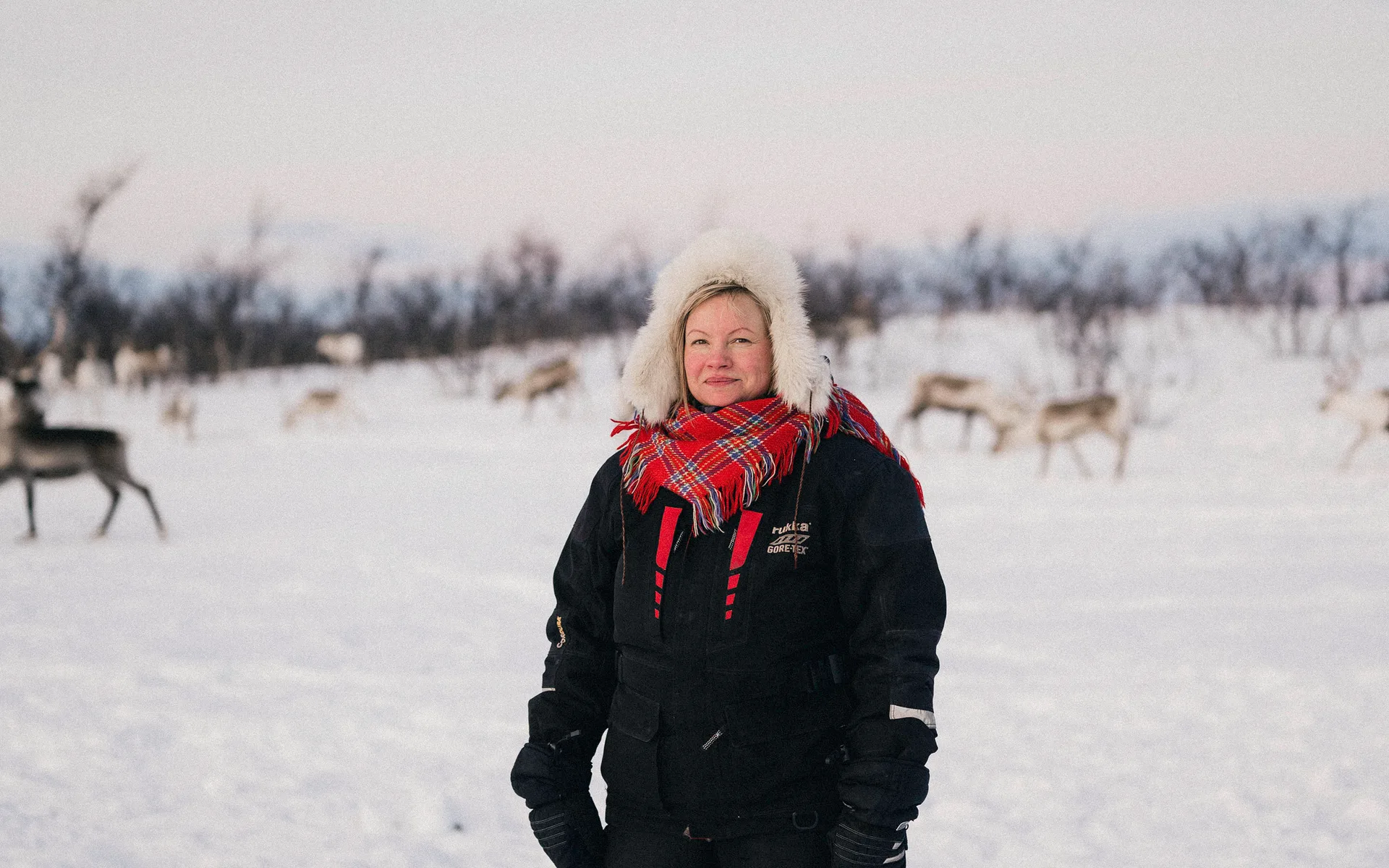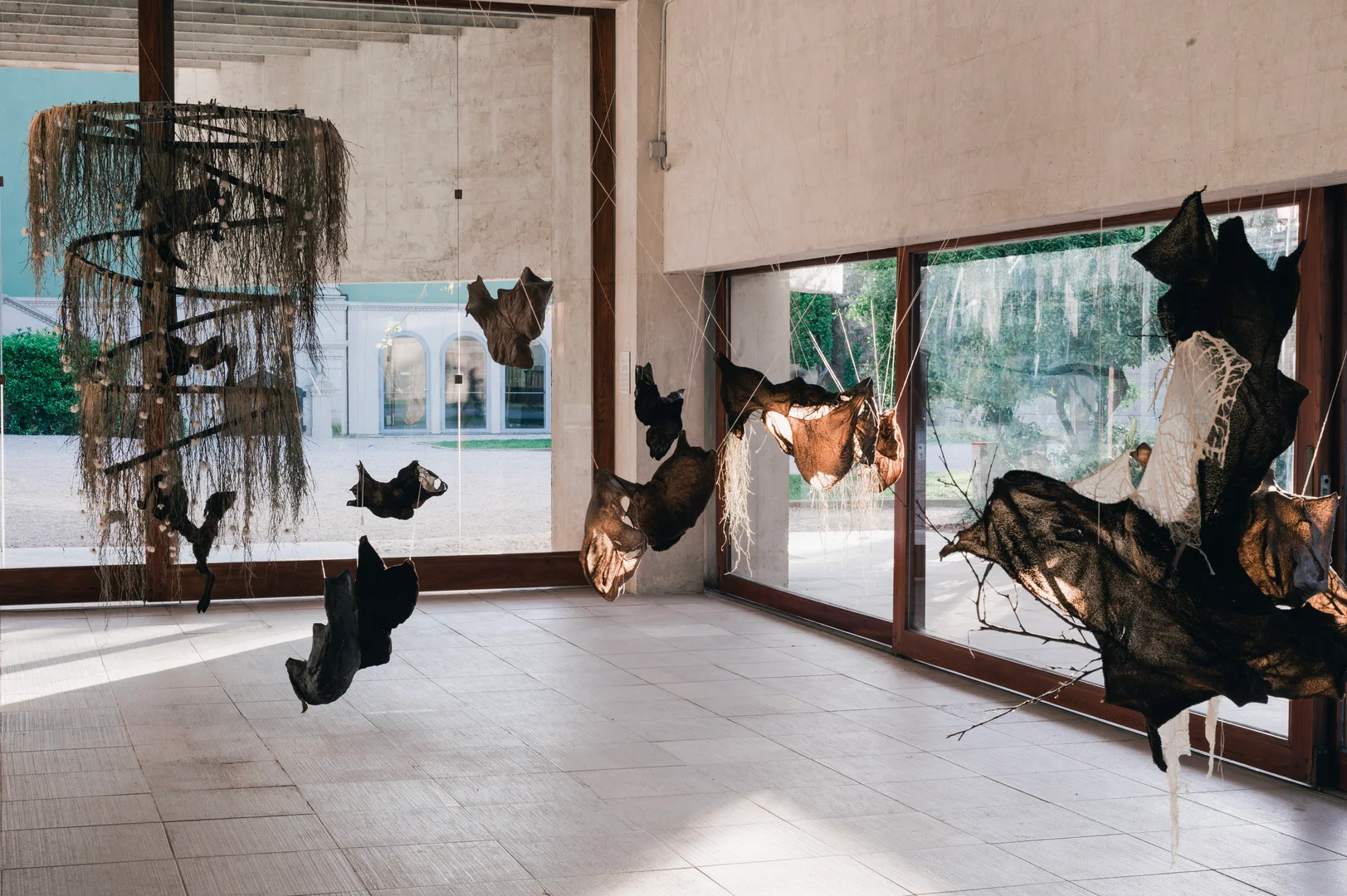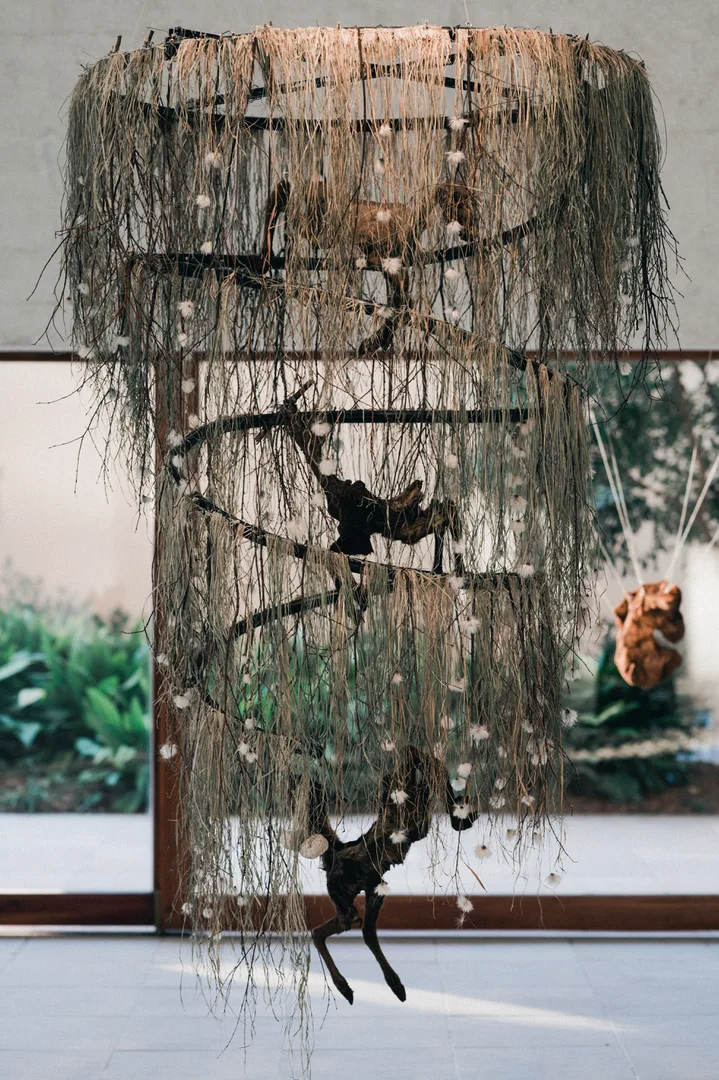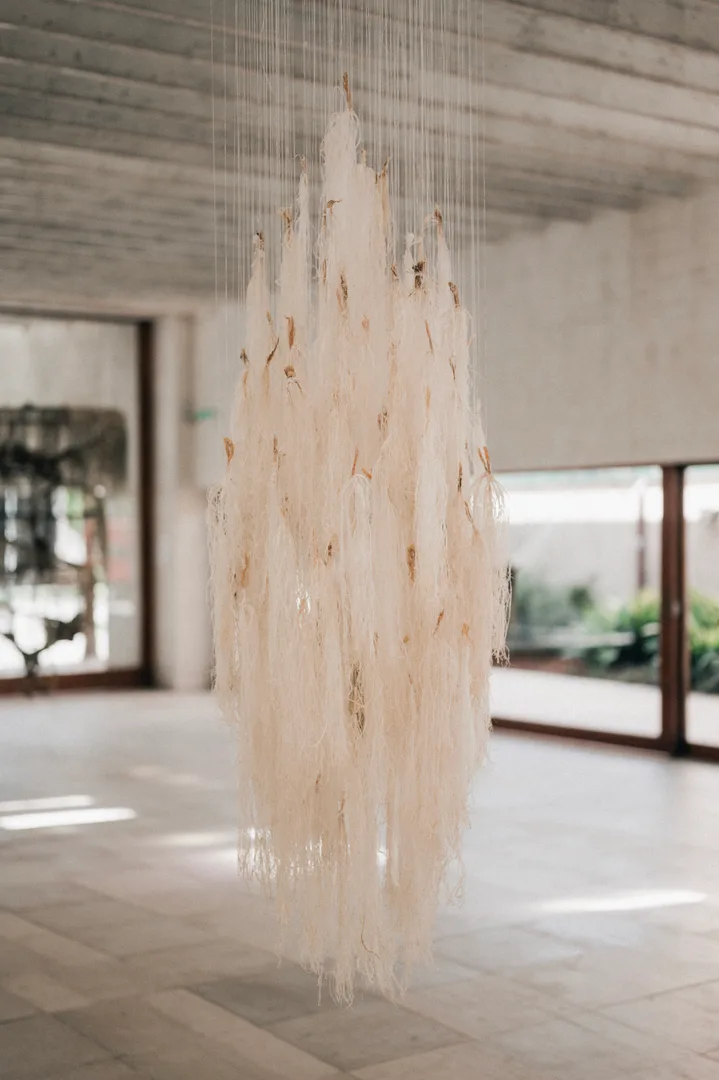
Máret Ánne Sara
Gutted – Gávogálši (2022)
Reindeer stomachs
Ale suova sielu sáiget (2022)
Cured red reindeer calves, cotton grass, birch branches, gámasuoidni (shoegrass)
Du-ššan-ahttanu-ššan (2022)
Reindeer sinews, wax, molecular compositions: fear (reindeer under stress, reindeer stools, diesel motors), hope (maternal breast milk, reindeer milk, newborns, tundra)
Smells created in collaboration with Nadjib Achaibou and Oswaldo Maciá.
Sámi Elder: Fimben Áillo Gáren / Káren E. M. Siri Utsi

Foreground: Máret Ánne Sara, Gutted – Gávogálši, (2022). Background: Máret Ánne Sara 'Ale suova sielu sáiget' (2022). Installation view 'The Sámi Pavilion'. Photo: Michael Miller / OCA

Máret Ánne Sara, Ale suova sielu sáiget, (2022). Installation view 'The Sámi Pavilion'. Photo: Michael Miller / OCA

Máret Ánne Sara, Du-ššan-ahttanu-ššan, (2022). Installation view 'The Sámi Pavilion'. Photo: Michael Miller / OCA
After the long and hard struggle our family has been through against the Norwegian state to protect our reindeer from forced slaughtering, I have a strong need to seek and manifest faith and hope. I tell my stories through the reindeer because what happens to the reindeer also happens to us. From an Indigenous perspective, I don’t see humans as superior or central. As human beings on this earth, we are simply a part of an interconnection of life forms and the constant dialogue and interdependence between these. My work asks questions about what happens when outside powers enforce laws upon you that systematically force you to break your own and collective ethics and morals, epistemology and philosophy. When your sanity is criminalised, how do you counter and continue?
—Máret Ánne Sara
Based in Guovdageaidnu, in the Norwegian side of Sápmi, Sara comes from a tundra reindeer herding family. The three works presented in the pavilion were conceived in the aftermath of a seven-year legal battle with the Norwegian state to defend the herding rights of her younger brother, one of the many court cases experienced by young Sámi reindeer herders today. Sara’s focus on the reindeer as the cornerstone of Sámi life is intended to heal and repair the inflicted trauma. The works were made following Sámi ethics and methods of sustainable resource use, finding value in reindeer parts not used for food and clothing; the animals presented died a natural death.
Gutted – Gávogálši is a constellation of dried reindeer stomachs addressing Sámi spiritual and material forms of knowledge and kinship. The work highlights the stomach as a first site of emotion to events in the world and underlines their sensate power as a parallel intelligence that connects humans, reindeers and other life. This gamus dovdat and čoalit dovdet, which translates as ‘we know by instinct’ and ‘gut feeling’, is highly valued by Sámi philosophy. Each stomach represents a person responsible for the conflicts recently experienced by the Sara family; in so doing, the artist redirects the trauma back onto the perpetrators, cleansing herself and her family from it.
Ale suova sielu sáiget is a rotating sculpture composed of cured calves and dried plants from the tundra, conceived as a carrousel of death and birth, fear and joy, trauma and hope. It was created whilst the artist was carrying her first-born and considered the future of Sámi youth in a colonially unbalanced world. Through the work the artist grieves the loss of the red newborn calves to state-imposed pressures (such as the effect of environmental laws over protecting alpha predators) as well as to starvation resulting from the growing impact of climate change; she rejoices in each calf born as the carrier of new life, as a continuation of the herd and of the Sámi people.
Du-ššan-ahttanu-ššan consists of two suspended, cloud-like forms of reindeer sinews, imbued with smell, as an elementary part of the non-verbal communication that happens between lifeforms and their surroundings. The smell in one of the forms conjures the ongoing stress and fear experienced by humans and reindeers during colonising processes; and in the other, the hope needed to resist and generate a new future.
Biografiijat
Máret Ánne Sara (r. 1983) lea davvisámi dáiddár ja girječálli Guovdageainnus Norgga bealde Sámis. Sara lea okta vuođđudeddjiin Dáiddadállu dáiddárkollektiivvas Guovdageainnus ja lea oassin ođđa buolvvas sámi dáiddáriin guđet gozihit ja nannejit sámi vuoigatvuođaid. Son lea dovddusin šaddan iežas geahččaladdi dáiddalaš bargovugiiguin go čalmmustahttá politihkalaš ja sosiála áššiid mat čuhcet sámiide, cuiggodemiin dan koloniserema mii erenoamážit váikkuha boazosápmelaččaide . Dávjá su skulptuvrrat ja installašuvnnat leat ráhkaduvvon ávdnasiin iežas bearraša ceavzilis boazodoalus, go árbevirolaš vugiin ávkkástallá bohcco dávttiin, náhkiin ja siskilušain, ja hábme dain ođđamállet dáidagiid.
Sara lea beaggán su installašuvnnain Pile o’Sápmi, mas leat 400 bohccooaivvi ja láhkabáberčoakkálmas, čájehuvvon documenta14 dáiddačájáhusas Kasselis, Duiskkas, 2017:s. Norgga Nationálamusea ostii gieskat dán installašuvnna. Pile o’Sápmi namma maiddái suorggidii vuosttaldan dáiddaprošektii, ovttas eará sámi dáiddáriiguin, doarjun dihte su nuorat vielja Jovsset Ánte Sara, riekteášši Norgga stáhta vuostá.
Dát namma čujuha Pile o’Bones áššái, Regina gávpogis, Kanadas, gos vierrásat njuovadettiin čohkkejedje buffalooivviid stuora gubáide. Kolonisttat vuortnuhedje taktihkalaččat First Nations álgoálbmoga guođđit iežaset árbevirolaš duovdagiid ja eallinlági. Pile o’Sápmi lea máŋgga hámis, installašuvdnan bohcco oivviiguin, ja čeabetčikŋan duddjojuvvon bohcco olloliin (čujuha dákte porselenai, mii lea Brihttalaš hutkkus atnit Buffalodávttiid porselena ráhkadeamis). Seammás go su vielja diggeáššit jotke, Sara ráhkadii iešguđetlágan Pile o’Sápmi installašuvnnaid daid iešguđet dikkiide; ovtta installašuvnna olggobeallai Sis-Finnmárkku diggegotti Deanus, nuppi olggobeallai Hålogalándda lágamánnerievtti Romssas ja olggobeallai Norgga Stuoradikki Oslos, go diggeášši lei alimusrievttis.
Dát iešguđetge hámát dáidagat leat maiddái leamaš čájáhusas Tenthaus, Norggas; Majestehta Dronnet Sonja Dáiddastálljas, Norggas; Kunstnerforbundet, Norggas ja Nuuk dáiddamuseas, Ruonáeatnamis. Pile o’Sápmi Power Necklace lei čájáhusas ‘Let the River Flow. The Sovereign Will and the Making of a New Worldliness' man OCA kuraterii ja buvttadii 2018:s. Sara lea dáid áiggiid oassin ođđa bargodoaimmas ja oasit su ovddeš bargguin ja dáidagiin leat čájáhusas ‘Environmental Injustice – Indigenous Peoples' Alternatives Musée d’ethnographie de Genève, Sveiccas.
Son lea gazzan illustrašuvdna oahpu Dáidda Universitehtas Bournemouthas, Englánddas, ja bargá ollu prentemiin ja hábme kollášaid main sámi symbolaid ja identitehtamearkkaid bokte govvida mielahisvuođa ja suhtu stáhta fámolaš veahkaválddálašvuhtii. Sara lea maid bargan journalistan ja doaimmaheaddjin sámi nuoraidmagasiinnas Š, ja lea almmuhan máinnasráiddu guvttiin girjjiin, Ilmmiid gaskkas, 2013, ja Doaresbealde doali, 2014. Son nammaduvvui davviriikalaš ráđi mánáid- ja nuoraid litteratuvrabálkášupmái su vuosttaš girjjiin Ilmmiid gaskkas, mii lea almmuhuvvon davvisámegillii, dárogillii ja eaŋgalagillii.